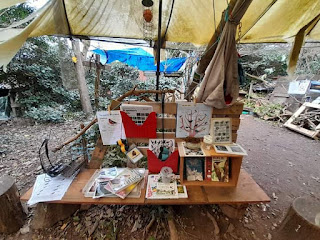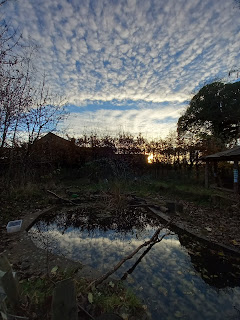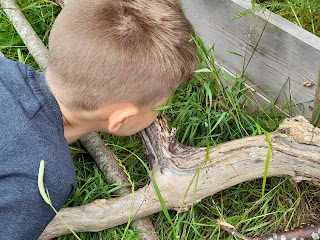What a Site!
One of the things I love about going to other Forest Schools is having a look around their site.
 |
| Isle of Scilly Forest School |
For those of you with an education background you'll know how enticing it is, it's like getting to sneak a peek at another school or classroom! For those who have visited friends in a new house, it's like getting to look around the whole thing!
Yes, it probably does mean those of us who understand this are a little bit nosy, but it also means we're great at squirreling away ideas!
There is no judgement of good or bad involved. Just a mental acknowledgement of how each has managed to incorporate a basecamp, or dealt with storage issues, or provided a shelter, or gets equipment onto site. It's a way of gathering information and ideas to use ourselves!
Forest School takes place outside, but that may well be the only thing two settings have in common. Yes, the more nature that is involved the better. Established grass, trees, bushes, mud, plants, etc, provide an amazing environment in which to provide sessions, but for many more urban spaces this isn't possible, so small shrubs and saplings may be all that are available. Planting your own Forest School will take decades to mature, meantime the children need to use that space.
Forest School is an ethos, a pedagogy, that says children thrive outside. Their wellbeing will benefit from a connection to nature, their physical health and immune system will strengthen from time spent with soil and fresh air, and their motivation, confidence, curiosity, and independence will grow through following their own interests and learning. What activities can be provided to support this will range depending on the site, but focusing on these aptitudes and traits can happen almost anywhere.
I have seen great sessions in the corner of a field with no trees nearby, enthusiastic children engaged in tasks while on layers of bark chippings (covering concrete) amongst planters with bushes in, and tiny school gardens providing opportunities to meet wildlife to just a few children at a time. All these are great examples of making the most of what you can provide. Of course, a rich, broadleaf woodland, close to a toilet block, with an accessible but not dangerous body of water, with a track close enough to allow a truckload of equipment to be driven on site is probably ideal! Hands up who has found this?!
Equally, I've seen genuine pieces of wild land tamed into something that is barely recognisable as wild, stripped of brambles and nettles, sanitised and made safe, and I've been in the heart of a forest and watched endless gluesticks, glitter, plastic beads, pens, and colouring-in sheets get unpacked from a rucksack. Activities that could've been done inside, ones that have no benefit from being outside, and ones with the potential to harm the outdoors.
Having a site that looks natural, that's untidy, muddy, and everchanging, may not look great on Instagram, but it is a place where children can meet wildlife, experience seasons and weather, and get messy!
When I go to a student's site they all, without fail, start by saying, 'our site isn't as good as yours...', by which they mean as large, or as established. It always makes me laugh because it's not really what I'm there to judge.
Chartham is lucky, we have space.
Some places have more.
Some places have better.
My role is 'dedicated', meaning I have no other job within the school other than Forest School, so my PPA and site time are solely there to develop our provision. Very few settings have that luxury. If you work within a school being a Forest School Leader is usually a role on top of the role you continue to have! Time to tidy, establish, and develop the space you use will be limited - especially if that space is used by others too!
If you work freelance you may rent a regular site, but not have permission to develop it. It may be a case of 'leave no trace' when you go. It may be a different site for each session. All these scenarios make spending time, energy, effort, and money on a setting less effective, and less appealing. Building up a solid set of resources is much more time and cost-effective.
Whether a site is 25 square metres of garden, a sectioned-off end of a playground, the park across the road, the field at the side of the school, or the deep, dark woods, looking at the space says nothing about the quality of Forest School provided.
It does allow us to see how other Forest School Leaders use pallets, tyres, or any number of treasures acquired while skip diving! It presents different solutions to universal problems like hand washing, toileting, and shelters. It introduces new storage and transportation ideas even before we look at actual equipment!
It is a full-size, 3D, Pinterest page that we can browse and discuss in real-time!
Everybody's provision of Forest School is influenced by their site, but also by their interests, the age and abilities of the children they cater to, the season, the weather, the length of a session, and who ultimately decides if Forest School happens at all. In many ways, no two sessions are the same - ever!
In my experience, we are all just happy to meet a kindred soul, someone who understands what we do and why we do it without explanation. We are great at supporting each other, championing each other, sharing ideas, and helping whenever and wherever we can.
My site is there for the children. An outdoor resource centre they can use to follow their interests, supply some answers, enhance their learning, and feel like a welcoming space. Whatever I change or introduce is with them in mind, often in response to a request, or because of something I observed about the children exploring. I'm not in competition with anyone else to have a 'better site' and I have no wish to adapt it to look more aesthetic for adults!
 |
| The children requested a book nook |
If I'm coming to your site to be nosy I want to see what you've done with your space and what ideas I can take away and use myself! If I'm coming to assess you as an FSL, then I want to see how you use the space you have to provide experiences for the children.
 |
| eyfs |
The way eyfs and year 6 use my site is different - although some things never change! The way one Year 4 class use it and the other Year 4 class experience it is different. Unless you are with me for at least a week you have no idea how good, bad, or ugly my setting is!
 |
| Year 6 |
A site is a site.
It will take an entire academic year before knowing exactly what you want from it.
It will take 4 full seasons before you are remotely aware of its drawbacks and its possibilities.
Love the space. Give it as much time and attention as you can. Ask the children what they want from it and what they want to do with it. Its potential will never be reached because it will change as it grows.
Along the way, you will figure out some brilliant enhancements and amazing solutions to problems you never knew existed!
 |
| Rocks & Crossed - tic tac toe |
 |
| scavenged broken chair |
 |
| bottle rack to hold birds off the table |
Share them!
That's all I ask!
And visit as many settings as you can!










Comments
Post a Comment